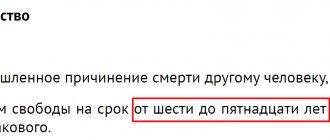ST 117 of the Criminal Code of the Russian Federation.
1. Infliction of physical or mental suffering through systematic beatings or other violent actions, if this does not entail the consequences specified in Articles 111 and 112 of this Code, is punishable by restriction of freedom for a term of up to three years, or forced labor for a term of up to three years, or imprisonment for the same period.
2. The same act committed: a) in relation to two or more persons; b) in relation to a person or his relatives in connection with the performance of official activities by this person or the performance of public duty; c) in relation to a woman who is known to the perpetrator to be pregnant; d) in relation to a person who is known to be a minor or a person who is known to be in a helpless state or in financial or other dependence on the offender, as well as a person who has been kidnapped or taken as a hostage; e) using torture; f) by a group of persons, a group of persons by prior conspiracy or an organized group; g) for hire; h) for reasons of political, ideological, racial, national or religious hatred or enmity, or for reasons of hatred or enmity towards any social group - is punishable by imprisonment for a term of three to seven years.
Note : In this article and other articles of this Code, torture is understood as the infliction of physical or mental suffering for the purpose of forcing a person to testify or take other actions contrary to the will of a person, as well as for the purpose of punishment or other purposes.
Torture - what is it?
The official definition of this concept is given in Part 1 of Article 117 of the Criminal Code of the Russian Federation. Namely: torture is the infliction of physical or mental suffering through systematic beatings or other violent actions , if this does not entail the consequences specified in Articles 111 and 112 of the Criminal Code of the Russian Federation.
In simple terms, torture is expressed in the infliction of any negative physical impact on the victim by the criminal, from which she suffers (stress, physical and emotional pain, humiliation, etc.). However, there are no signs of serious or moderate damage to the victim’s health.
Where to apply
A report of torture should be filed with the police. The application can be submitted in writing in person, orally by telephone or online to the police department at the place where the crime was committed. It should be borne in mind that cases of crimes under Art. 117 of the Criminal Code of the Russian Federation relate to cases of public prosecution that can be initiated by the police if they become aware of the fact of torture not from the victim herself, but from other sources, for example, from eyewitnesses of the crime or from those who were not eyewitnesses, but learned about him from other persons.
Kinds
Torture can be expressed in two main forms , which have several subtypes.
- Systematic beatings . In this case, systematicity should be understood as numerous blows inflicted by the criminal on the victim at least 3 times. That is, if the culprit hit (tortured) the victim again several years later, such treatment of a person will not be punished under Article 117 of the Criminal Code of the Russian Federation.
- Other types of violencethat cause suffering to the body and psyche of the victim. This includes causing pain for a long time by:
- pinching;
- sections;
- causing multiple (significant and minor) harm to the body with the help of sharp and blunt objects;
- exposure to thermal factors;
- prolonged deprivation of food, water or heat;
- placing the victim (leaving him) in conditions harmful to health, etc.
Examples of torture include torture with a hot iron or boiling water, blows with a stick or baton, exposure of the victim to open fire, injections, and small cuts on the skin with a knife.
Corpus delicti
Traditionally, the elements of a criminal act include: the object and the objective side, as well as the subject and the subjective side. Each of the components of Article 117 of the Criminal Code of the Russian Federation is described in more detail below.
Object and objective side
The direct object of the crime under Article 117 is the health of the citizen. In this case, there is no mention of a person’s life, because serious or moderate harm to the victim is excluded . Actions that fall under the signs of torture cannot lead to any significant consequences for the life of the victim in advance.
The objective side is understood as the act of the culprit in the form of an action - causing suffering (both to the body and the human psyche) through systematic beatings and other types of violence listed above.
Subject and subjective side
The subject of the composition in question is a sane 16-year-old individual , and the subjective side is expressed exclusively by direct intent.
By mocking the victim, the criminal (torturer) wants him to experience physical and moral suffering and, therefore, deliberately mocks him, continuously committing negative actions.
Qualifying features
Their list is contained in Part 2 of Article 117 of the Criminal Code of the Russian Federation. The attacker will face a more severe punishment if at least one of the following conditions of torture is present :
- In relation to 2 or more persons.
- When a criminal commits a crime in relation to a citizen who is at that time in the service or performing a public duty (or in relation to his relatives).
- Torture of a pregnant woman when the perpetrator knew about it in advance.
- In relation to a minor (and the culprit knew about his age) or a helpless person (in particular, if there is a financial dependence between the criminal and this person).
- If the victim is kidnapped or taken hostage.
- Using torture.
- When torture is carried out by several persons (with or without prior agreement, or it can be an organized group).
- By hiring another person to carry out the torture.
- If at the time of the crime the victim had motives of hatred (or enmity) based on politics, ideology, race, nationality or religion.
Aggravating circumstances
Aggravating circumstances under Part 2 of Art. 117 is considered torture:
- two or more persons;
- a person or his relatives in connection with the performance of official activities by this person or the performance of public duty;
- in relation to a pregnant woman;
- torture of a minor or child, a person known to the perpetrator to be in a helpless state, financially or otherwise dependent on the perpetrator, abducted, hostage;
- with the use of torture (they mean the infliction of physical or mental suffering in order to force the victim to testify or other actions contrary to the will of a person, for the purpose of punishment and for other purposes);
- a group of persons, a group of persons by prior conspiracy or an organized group;
- for hire;
- based on political, ideological, racial, national or religious hatred or enmity.
In addition, criminal law (Article 63 of the Criminal Code of the Russian Federation) specifies types of aggravating circumstances that aggravate the guilt of the accused of a crime, regardless of what article it is classified under. These include, in particular:
- relapse (repeated commission of a crime under the same article);
- involvement in the commission of a crime of persons who suffer from severe mental disorders or are in a state of intoxication, as well as persons under the age of criminal responsibility;
- revenge for the lawful actions of others.
These circumstances will also be taken into account by the court when sentencing the accused under Art. 117 of the Criminal Code of the Russian Federation.
Sergey Alekseev Lawyer, website author
Expert commentary
Demarcation from adjacent trains
Related elements of Article 117 of the Criminal Code of the Russian Federation are:
- Causing grievous bodily harm with particular cruelty, mockery or torture (clause “b” of Part 2 of Article 111 of the Criminal Code of the Russian Federation).
- Clause “c” of Part 2 of Article 112 of the Criminal Code of the Russian Federation is a similar act to the previous one, only in this case the victim is harmed to health of moderate severity.
- Article 116 of the Criminal Code of the Russian Federation – beatings.
Reference. The difference between torture and the provisions of Articles 111 and 112 of the Criminal Code of the Russian Federation is that in the first case the consequences are not similar to those that arise for the victim when severe or moderate damage to health is inflicted.
In other words, the victim does not lose his ability to work for a long time, does not lose any organ , does not acquire a serious illness, etc.
In addition, the subject of the above-mentioned compounds causing damage to health can be a person who is already 14 years old . As is known, for more serious crimes the age of responsibility decreases.
As for the difference between torture and beating, it lies in systematic actions : when the victim was beaten for some time, for example, daily or several times a week. When qualifying violent actions as beatings under Article 116 of the Criminal Code of the Russian Federation, this sign of constant violence against the victim is not present .
An attacker who once committed a beating that did not cause a slight degree of harm to the health of a citizen (and damage of other degrees as well. Read more about determining the degree of severity here), will be prosecuted under the article “Beatings”, and not “Torture”.
On forms of non-physical (psychological) violence in the criminal legislation of Russia 298
Violent crimes are among the most dangerous among other forms of illegal activity, primarily due to the encroachment on such important and often irreplaceable objects as life or health. And although the number of such crimes is not at the top of the crime structure, the consequences of their commission are very significant.
The problems of preventing violent crime still remain relevant, despite the many measures taken both in Russia and foreign countries. According to official statistics, in 2021, 2,058,476 crimes were registered in the Russian Federation. The categories “violence” or “violent crime”, of course, are not included in the structure of crime, but information relevant to this study can be gleaned from data on other crimes. The share of crimes against the person was about 14%, of which in January-December 2021, 9,738 murders and attempted murders were committed, as well as 24,552 episodes of intentional infliction of grievous bodily harm. As a positive point, it should be noted that compared to the previous year, there is a tendency to reduce the number of violent crimes [10]. At the same time, we note that this does not always indicate a reduction in the real number of violence in society. It is enough to point out the partial decriminalization of beatings, the statistical consequence of which should be considered an increase in the number of administrative offenses provided for in Art. 6.1.1. Code of Administrative Offenses of the Russian Federation. In the absence of partial decriminalization, this number would appear in criminal statistics.
The problem of countering violence in foreign countries is quite acute. In the United States, for example, according to research by individual authors, attacks with firearms that result in harm to the life or health of several victims occur on average every day. In addition, from 2012 to 2021 there are more than 1,500 such cases [26, p. 541-542]. In Canada, despite a decline in the overall level of domestic violence, the number of victims remains fairly stable. In 2021, their number was 239 for every 100,000 population [16, p. 34-37].
Thus, we can note a general positive trend towards a reduction in the number of violent crimes, while their value remains high.
Despite the abundance of various scientific works related to the study of types of violence, in the theory of criminal law this phenomenon is divided mainly into two categories.
The first category includes physical violence, which is traditionally characterized by a greater degree of research. Its forms of manifestation and consequences of implementation are more obvious, so such close attention of science is understandable.
The second category has been studied to a much lesser extent. It is worth paying attention to the fact that even its name is controversial. Most legal authors talk about “mental violence,” others reasonably call this phenomenon “psychological violence.” A relatively rare term such as “emotional violence” is also found in foreign and domestic literature.
In one of our earlier studies of the problems of countering violence, in our opinion, we were able to convincingly prove the need to use a new construct that covers all forms of violence that are not physical [6, p. 103-104]. In this regard, in this work, the verbal construction “non-physical violence” will be used in the future, since this allows us to cover a wider range of issues.
Despite the fact that in theory and practice, physical violence is quite reasonably recognized as a more dangerous manifestation, non-physical violence should also not be ignored, since the consequences of the above attacks can sometimes be comparable. Human health does not consist of autonomous, but of interconnected components that influence each other. Damage to mental health can affect physiology, and vice versa.
In addition, the development of methods of encroachment does not stop at present. Methods of immersion in a hypnotic state, previously available to a limited circle of people, are now spreading to a greater extent, which is associated with the development of the information society. One of the well-known scientific achievements is the implantation of false memories into the brains of mice, allowing them to change their attitude towards certain phenomena [22, p. 494-495]. The use of such methods in relation to a person can lead to both positive and negative consequences, especially if they are used by representatives of crime.
The problem that this study is devoted to is the incompletely correct reflection of forms of non-physical violence in criminal law. Accordingly, the purpose of the work was to study the problems of reflecting forms of non-physical violence in criminal legislation, aimed at developing recommendations for improving criminal law norms in the direction of increasing their effectiveness.
In the scientific literature, the problem of enshrining types of non-physical violence in legal norms has not received a clear solution, although its analysis has been carried out repeatedly. A number of authors point out that violence is reflected in criminal legislation only as a method of committing a crime [9, p. 164-167]. Others consider “non-physical violence” a more meaningful category [8, p. 59-60].
Quite a lot of works are devoted not to violence in general, but only to its individual types. For example, phenomena such as threat have been analyzed in sufficient detail [12, p. 525-526; 3, p. 14-18], coercion [5, p. 61-63], cruel treatment [7, p. 142-143], hypnosis [11, p. 210-211] and others.
Among foreign authors, a significant number of studies have recently been devoted to non-physical violence in cyberspace [23, p. 27; 24, p. 136; 25]. In particular, the authors focus on legal measures to combat cyberbullying - bullying and humiliation that is committed via the Internet [17, p. 1-7]. At the same time, some scientists propose to apply the current legislation, while others insist on fundamentally new solutions [21]. The legal problems of creating and distributing pornographic images of people for the purpose of causing them mental suffering are touched upon [20, p. 397]. Of great interest is also the work devoted to the study of cyberstalking, i.e. the pursuit of one person by another via the Internet. The authors note that the legislation does not reflect the attitude of people towards this phenomenon, who often perceive it as a threat [18, p. 83-84].
The current domestic criminal legislation in the articles of the Special Part contains prohibitions on the implementation of several different manifestations of non-physical violence. An analysis of the provisions of the Special Part of the Criminal Code of the Russian Federation made it possible to determine the frequency of occurrence of one or another manifestation of non-physical violence with the reflection of the obtained data in Table. 1 and diagram (Fig. 1).
Table 1
Forms of non-physical violence in the articles of the Special Part of the Criminal Code of the Russian Federation
| Form of non-physical violence | Articles of the Special Part of the Criminal Code of the Russian Federation | Total number of articles containing this form of non-physical violence |
| Threat | 110, 119, 120, 126, 127.1, 127.2, 131, 132, 133, 139, 141, 142, 144, 148, 149, 150, 151, 151.2, 161, 162, 163, 166, 170.1, 178, 179, 183, 185.5, 203, 205, 211, 221, 226, 227, 229, 230, 230.1, 240, 241, 244, 282, 283.1, 286, 296, 302, 309, 313, 318, 321, 322, 330, 333, 361 | 52 |
| Compulsion | 120, 141, 142, 144, 147, 149, 179, 184, 185.5, 240, 283.1, 302, 309, 333 | 14 |
| Blackmail | 127.2, 133, 185.5, 230.1, 283.1, 302, 304, 309 | 8 |
| Mockery | 107, 111, 112, 113, 302, 335 | 6 |
| Insult | 107, 113, 297, 319, 336 | 5 |
| Cruel treatment | 110, 156, 356 | 3 |
| Humiliation | 110, 282, 335 | 3 |
| Slander | 128.1, 298.1, | 2 |
| Causing mental suffering | 117 | 1 |
Rice. 1.
Correlation of forms of non-physical violence in the articles of the Special Part of the Criminal Code of the Russian Federation
Analysis of dispositions shows that in most cases a threat is provided as constructive or qualifying characteristics. At the same time, the content of the threat is quite differentiated. Most often, the Criminal Code of the Russian Federation prohibits the threat of violence, for example, in Articles 119, 126, 131 of the Criminal Code of the Russian Federation and others. This is quite logical, since this form of violence is implemented quite simply for the perpetrator and, in fact, can potentially support a host of crimes.
Close in meaning is the content of a threat to destroy or damage property. Objectively, this form is characterized by a lower degree of public danger, and therefore this sign is found only in some crimes provided for, for example, by Articles 142, 163 of the Criminal Code of the Russian Federation and others.
Even less common in criminal law is the threat of disseminating any information (Articles 163, 179 of the Criminal Code of the Russian Federation). At the same time, it should be noted that if the specified information is false and may negatively affect the honor, dignity or reputation of another person, then its dissemination in itself is already an unlawful act under Art. 128.1 of the Criminal Code of the Russian Federation. The presence of such a crime explains the rather rare use of the threat of dissemination of information as constructive or qualifying characteristics.
In addition, in a number of dispositions the word “threat” is used without specifying the content. This allows us to conclude that in such cases, criminal law prohibits threatening anything, including violence, destruction or damage to other people’s property, dissemination of information, etc. As an example, we can cite the elements of crime provided for in Articles 150 and 151.2 of the Criminal Code of the Russian Federation.
Based on the above, we consider it possible to agree with the opinion of E.N. Barkhatova that the content of the threat is the impact on the mental activity of the victim by informing him of information about the commission of actions that are undesirable for him or those close to him [1, p. 23].
The next most common form enshrined in criminal law is “coercion,” which is found in fourteen articles. Coercion and threat have coinciding characteristics, which in some cases is confirmed by acts of the Supreme Court of the Russian Federation. Thus, in paragraph 14 of the Resolution of the Plenum of the Supreme Court of the Russian Federation dated April 26, 2007 No. 14 “On the practice of courts considering criminal cases of violation of copyright, related, inventive and patent rights, as well as illegal use of a trademark” it is clarified that violation of inventive or patent rights by forcing co-authorship may involve exerting influence in any way (including through violence, threats of adverse consequences for the victim).
In this regard, some scientists argue that threat is the only possible manifestation of mental (non-physical) violence. In our opinion, coercion and threat are still correlated as a whole and a part, i.e. coercion includes a threat or other actions, while threats can be made with violence or other undesirable actions, but not with coercion.
In addition, we note that determining the essence of this form of non-physical violence is more difficult than it seems at first glance, since, as S.V. correctly points out. Shevelev, the legislator puts various meanings into the term “coercion,” including by attributing this phenomenon to independent elements of a crime, methods of committing them, or to circumstances excluding the criminality of the act [13, p. 171-172].
The next form of non-physical violence enshrined in the Criminal Code of the Russian Federation is blackmail, which has much in common with both the threat and coercion discussed above. In the absence of a legal definition of this form, in the theory of domestic and foreign criminal law, in general, general features of the content of this phenomenon are distinguished. For example, Yu.A. Nikitin emphasizes that blackmail is a method of committing a crime in which a threat is made to disseminate information specified in the law about the victim or his relatives [4, p. 63-64].
A similar opinion is expressed in foreign literature. In particular, the authors understand blackmail as an illegal demand for payment or provision of services under the threat of disseminating information [15].
The next most common manifestation of violence is bullying, which acts as a qualifying feature of certain crimes against health, justice, and military service. Bullying can be carried out both in physical form (spitting, slapping, etc.) and in non-physical form (intimidation, humiliation). It should be noted that, like previous manifestations, bullying can be expressed in the form of threats. In any case, bullying is characterized by rudeness and cynicism, and its use indicates that the subject wants, among other things, to inflict moral suffering on the victim.
Despite the fact that the crime provided for in Art. 130 of the Criminal Code of the Russian Federation was decriminalized; special offenses are still provided for by criminal law. Currently, insulting participants in court proceedings, government officials and military personnel is punishable. At the same time, the legislator identifies insult, but in relation to the subject of the crime, as the causes of passion, in particular in Articles 107 and 113 of the Criminal Code of the Russian Federation.
This manifestation of violence can also be physical, as well as non-physical. Unlike previous forms, an insult in the form of a threat is unlikely, although the threat may consist, among other things, of insults.
Other forms of expression of non-physical violence in criminal law include cruel treatment, humiliation and infliction of mental suffering.
The theory of criminal law ambiguously resolves the issue of classifying deception and slander as manifestations of violence. Slander, of course, refers to methods of psychological influence, although its violent signs are not always obvious. Indeed, this unlawful act is rarely associated with a direct impact on the psyche of the victim. The subject of the crime first of all seeks to change the assessment of the victim’s personality on the part of other persons by providing them with false information.
However, we believe it is possible to agree with the position of M.S. Fokina and V.E. Dvortsov regarding the fact that repeated dissemination of slander as a component of bullying the victim can be attributed to non-physical violence, expressed in the form of systematic humiliation of honor and dignity [2, p. 270-271].
As for deception, this phenomenon, it seems, is not identical to violence, since it is not the deception itself that causes moral suffering to the victim, but, for example, damage from the loss of property during fraud. In the event that a deliberately false denunciation, deliberately false testimony, an expert or specialist opinion, or an incorrect translation are committed, it becomes not entirely clear who is being violated? Over the investigator, interrogator or court? It seems that the answer will be negative, while such crimes, of course, are not committed without deception.
Despite the fairly differentiated range of forms of manifestation of non-physical violence enshrined in criminal legislation, it seems that it remains incomplete.
For example, significant difficulties in qualifying and assessing public danger were caused by crimes committed using hypnosis or in a state of trance. Quite a lot of attention has been and is being given to hypnosis in the scientific literature, but, according to scientists, this phenomenon still remains insufficiently studied. There are also statements that hypnosis does not exist at all, despite a lot of evidence to the contrary cited in the literature [19, p. 510].
As for criminal law relations, there are many established facts of the use of hypnosis for criminal purposes. Currently, such cases also occur, although, compared to other methods of committing illegal acts, they are relatively rare.
For example, as follows from the verdict of the Leninsky District Court of Ufa dated May 10, 2017 in case No. 1-18/2017, F.D.Kh. was found guilty of creating a non-profit organization “Horde”, encroaching on the personality and rights of citizens (Article 239 of the Criminal Code of the Russian Federation). F.D.H. forced victims to participate in events of a religious association by putting them into a trance. As confirmed, including by the conclusion of a clinical-psychopathological study, the rituals presented in video and audio recordings contain signs of psychological influence in the form of suggestion and the use of psychotechnologies to manipulate people’s consciousness. These methods of psychological influence can have a negative impact on human health, provoke a maladaptive state, even a mental disorder[1].
Hypnosis is most often used for attacks on property relations, as well as life and health. At the same time, it is not entirely clear what type of violence it should be classified as, and whether this phenomenon is violence in principle or simply a method of influence?
Since in the theory of criminal law, in the context of interpreting the content of Article 40 of the Criminal Code of the Russian Federation, it is traditionally believed that physical coercion includes cases of forced use of medications, it seems that induction into a trance state with the help of various substances (for example, sodium teopental) should also be attributed to physical influences. In all other cases, hypnosis seems to be attributed only to non-physical influences.
As for determining belonging to manifestations of violence, I think this is possible, albeit taking into account specific actions when inducing a state of trance. If, with the help of hypnosis, a person is forced to take actions that are contrary to his will, and the nature of which he is aware of (for example, harming himself or others, giving away property), then all the signs of violence are present.
Otherwise, with the help of hypnosis, a person’s perception is changed, after which some phenomena are perceived differently. So, for example, in a state of trance and after appropriate suggestion, a person can perceive the sheets of paper handed over to him as real banknotes in circulation. In such a situation there is a significant resemblance to deception, which, as we indicated above, is not identical to violence.
A study of forensic investigative practice, it should be noted, shows that basically property crimes using hypnosis are classified as fraud. Therefore, hypnosis is equivalent to deception. Of course, it is easier to prove the fact of misrepresentation than the impact on the psyche, which affects the result of qualification, however, law enforcement indicators should not be ignored.
If the use of hypnosis in crimes against property were recognized as violence, then what was done in practice would be classified as robbery or robbery, depending on the possible consequences for health. Moreover, forced hypnosis should not be ruled out, because when put into a trance, property can be confiscated not by misleading, but by direct commands to transfer the thing and, for example, by inducing amnesia. Individual scientific research speaks in favor of the possibility of such a development of events [14, p. 790-791], as well as foreign legislation [1, p. 52-58].
Thus, in our opinion, hypnosis can act both as an act of violence (physical and non-physical) and as a non-violent psychological influence. Considering the fact that a number of thefts, crimes against life and health, and even against public morality can be committed using hypnosis, it seems possible to introduce this feature into the relevant articles of the Special Part of the Criminal Code of the Russian Federation. Based on the fact that this form of influence increases the social danger of the crime, the sign should characterize qualified crimes. Fixing the sign associated with the use of hypnosis will resolve a number of existing qualification problems, for example, those arising regarding the distinction between robbery and fraud.
Thus, the study allowed us to draw the following conclusions.
1. Deception is not a type of violence, since in itself it does not cause moral suffering to the victim. This position is reflected in criminal law, since acts that include deception are not considered violent (for example, fraud or deliberately false denunciation). At the same time, deception is certainly a form of psychological influence.
2. Criminal legislation does not contain all forms of socially dangerous non-physical violence, including hypnotic violence. It seems necessary to consolidate the use of hypnosis as a qualifying feature in some crimes. The addition of such a feature is possible, for example, in the compositions provided for in the following articles: 110, 110.1, 111, 112, 115,120, 131, 132, 150, 151, 151.2, 159, 161 of the Criminal Code of the Russian Federation, etc.
Improving the law in the above way will allow us to resolve a number of qualification problems, for example, those arising regarding the distinction between robbery and fraud. In addition, taking into account the use of hypnosis will contribute to the correct individualization and differentiation of punishments.
[1] From the materials of the criminal case No. 1-18/2017 on charges of F.D.Kh. in committing a crime under Part 3 of Art. 293 of the Criminal Code of the Russian Federation // Leninsky District Court of Ufa.
Responsibility
Since torture is a serious crime, the punishment for it has several alternative options, including deprivation of a person’s freedom.
Namely, part one of the article under consideration contains the following penalties (they can be assigned for a period of up to 3 years):
- restriction of freedom (for example, a ban on leaving the city, changing place of residence, visiting certain places);
- forced labor (obligation to work for the purpose of re-education);
- imprisonment (placement of a convicted person in a colony).
Part two of the article lists qualifying features - aggravating circumstances (they were already mentioned in the article), for which an even more severe sanction is provided - imprisonment for a term of 3 to 7 years.
Important. When choosing the type of punishment, the judge is guided by all the circumstances of the case, the nature of the relationship between the victim and the convicted person, etc.
Criminal liability
Criminal Article 117 for torture provides for two types of punishments - for an “ordinary” crime and for a crime with aggravating circumstances.
In Art. 117 aggravating circumstances aggravating the guilt of the accused are given explicitly. Criminal liability for torture provides for the following penalties:
- for bullying a person, restriction of freedom for up to 3 years, or forced labor for up to 3 years, or imprisonment for up to 3 years (Part 1);
- for aggravated torture, imprisonment from 3 to 7 years (Part 2, details below).
For comparison: the maximum punishment for beatings under Art. 116 of the Criminal Code of the Russian Federation – imprisonment for up to 2 years.
Sergey Alekseev Lawyer, website author
Expert commentary
Comments on Article 117 of the Criminal Code of the Russian Federation
What does systematic beating mean?
Comments on Article 117 of the Criminal Code of the Russian Federation indicate that this is a chain of interconnected actions that are united by the general manner of behavior of the attacker towards the victim .
In addition, all actions are aimed at causing constant physical or mental suffering in relation to him , achieving feelings of humiliation and resentment. In light of this sign of torture, some isolated beatings and other acts of violence cannot be considered as such.
If, as a result of violence, the victim’s health is nevertheless caused harm (severe or moderate), this will be qualified under other articles, and additional application of Article 117 will not be required.
Causing mental suffering through threats will not be considered torture. If this sign is present, crimes may fall under Article 119 of the Criminal Code of the Russian Federation.
The corpus delicti under Article 117 is considered formal , that is, it will be completed at the moment of the act itself and for the culprit to be held accountable, the occurrence of any consequences dangerous to society does not need to occur.
What is meant by material or other similar dependence between the victim and the criminal?
There is also a comment on this subject: this sign should be understood as the dependence of the victim in such circumstances :
- dependency;
- living with the culprit in the same living space;
- official communication (between superior and subordinate);
- in an educational institution (between teacher and student).
Purpose of torture
In order for the actions of a criminal to be qualified specifically under Article 117, he must have goals. Most often, the goal is to induce the victim to take actions that are contrary to his interests and will. In specific situations, these may be different actions. For example:
- Receiving the information;
- Obtaining recognition of committed actions;
- Coercion to sign documents and other actions of this kind;
- Sexual perversion and dissatisfaction;
- Mental disorders of the attacker.









